Well, I suppose I'm not really telling the truth here. You
can indeed unintentionally kill these houseplants — but only if you love them to death. So if you are one of those gardeners who say, "I can't grow houseplants; I always kill them," take a look at these eight nearly bulletproof options, take a deep breath and go for it.
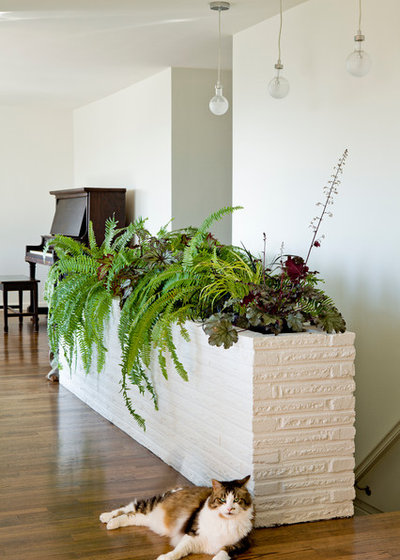
Jessica Helgerson Interior Design
1. Ferns. I love this family of plants, with their lush green tropical growth. When I hear people say they kill ferns, I tell them to remember where these plants come from in nature and try to duplicate those conditions. While we can't create a rainforest in our living rooms, we can give ferns regular watering once a week, bright but indirect light and weekly misting with a water bottle to imitate the humid conditions they love.
Look for the traditional
Boston fern (Nephrolepis exaltata) or
lemon button fern (Nephrolepis cordifolia); though not technically ferns,
asparagus fern (Asparagus densiflorus) and foxtail fern (
Asparagus densiflorus 'Meyersii') also make great houseplants.
Tip: If you wind up almost killing your fern, simply cut it back and resume watering; you'll probably see renewed growth fairly soon.
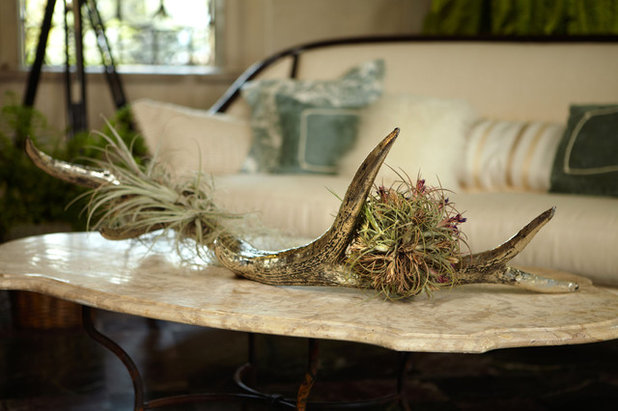
Margie Grace - Grace Design Associates
2. Tillandsia. Any plant commonly called air plant has got to be easy, right? Tillandsias need no soil to grow — what's easier than that? A member of the bromeliad family, tillandsias get their nourishment from the surrounding environment (air, humidity etc.).
These otherworldly plants feature leaves that can be stiff, soft, straight or curly, in a wide variety of colors from green to gray to red. Some have incredible blooms that last for weeks — in all, a great choice for those who want something a little unusual in their houseplant display.
Display them on walls, hang them on thin wires or tuck them into shells, bowls or driftwood. Give them bright light and good air circulation (no closed terrariums, thank you) and mist them with a spray bottle once a week.
Tip: You can also give tillandsias a weekly soak — dunk them quickly into water and then let them dry out on a towel before putting them back into their display.
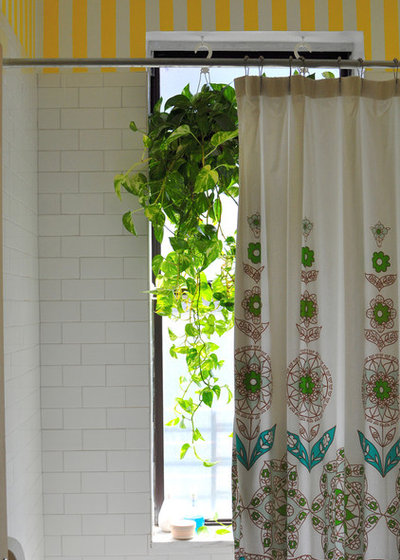
Scheer & Co.
3. Pothos (Epipremnum aureum). There's a reason people have grown this plant for so many years (some plants have survived for decades): You can forget you even have it, and somehow it still keeps right on growing.
This leafy vine can grow up to 40 feet long out in the wild, but in your living room, you can expect it to grow several feet. Keep it full and bushy by periodically trimming the longer leggy vines, providing bright but indirect light and deeply watering it twice a month.
Tip: If you forget to water enough, this plant will simply wilt. If that happens, thoroughly soak it and remove any dry or dead leaves, and it should perk up fairly quickly.
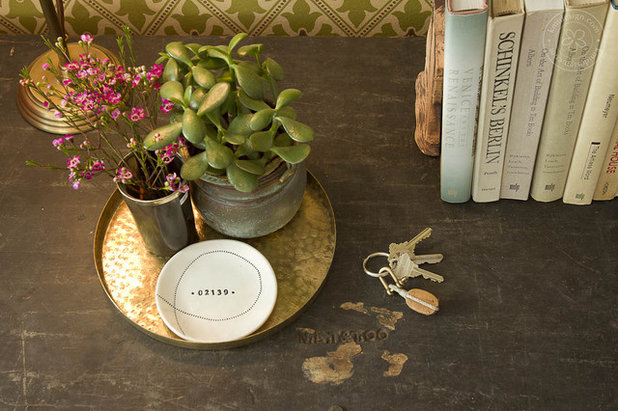
Kate Maloney Interior Design
4. Jade plant (Crassula ovata). Also known as friendship tree or money plant, jade plant has been widely used as a houseplant for many years. It has plump, glossy leaves on thick stems and can grow up to 4 feet tall if it likes the conditions.
Give it good light and low water (about once or twice a month), make sure your potting soil is well drained and never let this plant sit in water for long.
Tip: The leaves will wrinkle if you're underwatering. If you notice this, drench the soil with water but then let it slightly dry out before watering again.
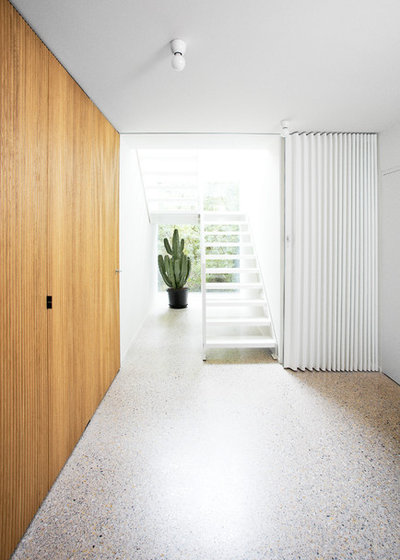
ARTerior Design
5. Cacti (
Cactaceae spp). This large family of plants is so drought tolerant that watering once a month is usually sufficient.
All cacti are succulents with spines that have spine cushions. There are so many forms to choose from — taller forms, like Mexican fence post (
Pachycereus marginatus);
rounded shapes, like golden barrel cactus
(Echinocactus grusonii); or the more diminutive spinystar
(Corypantha vivipara).
Most prefer bright indirect light, and some can take light by a bright window. Allow the soil to dry out in between waterings and use a weak cactus fertilizer once a month to encourage steady growth.
Tip: To plant prickly plants like cacti, fold newspaper into a long strap and gently wrap it around the cactus. This will protect your hands from being poked as you move it into its pot.
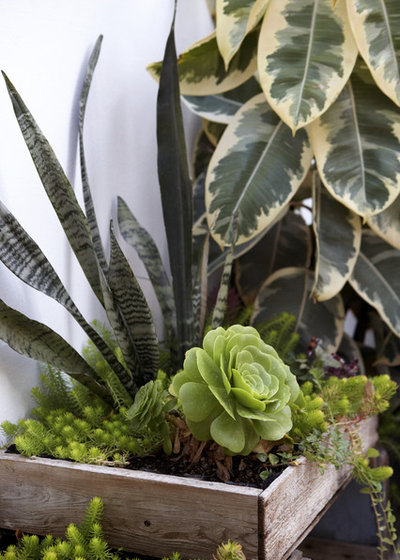
Urban Nature / Troy Silva Design Group
6. Sansevieria (
Sansevieria spp). Also called snake plant and Mother-in-Law's Tongue, this tried and true plant takes almost total neglect and scoffs it off. Got low-light interiors? Have almost no time to water? Don't like fussy flowers? Sansevieria is your plant.
The stiff, upright lance-like leaves typically have white or yellow edges or darker green stripes. Now before you say, "Yeah, my mom used to grow that plant — no thanks," take a look at some of the newer and different varieties. The one pictured here is
Sansevieria trifasciata 'Black Coral' (shown with Aeonium and sedum);
it features more rounded foliage and fits very well with contemporary interiors.
Water it once or twice a month and make sure the soil is well drained —
never let it sit in standing water.
Tip: This plant will rot if you water it too much, so if in doubt, underwater.
Read more about using
sansevieria in your house
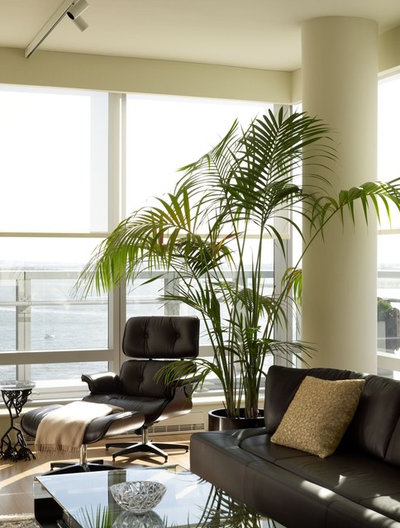
Incorporated
7. Palm trees. If you want a dramatic vertical element with a tropical feel, reach for the palms. Not all palms do well indoors, so it pays to know which ones do.
The best indoor palms are kentia palm
(Howea forsteriana), sentry palm
(Howea belmoreana), lady palm
(Rhapis excelsa) and parlor palm
(Chamaedorea elegans).
Avoid majesty palm
(Ravenea rivularis), even though it is widely sold as an indoor palm, queen palm
(Syagrus romanzoffiana) and butterfly palm (
Dypsis lutescens). Most indoor palms will enjoy a steady supply of water, light fertilizer once a month and bright but indirect light.
Tip: Trim off old, brown leaves once or twice a year, or as you see them appearing. The old foliage of many palms needs to be periodically removed and doesn't mean the plant is struggling.

NatureMaker
8. Ficus trees (Ficus benjamina). Remember that ficus tree in your college dorm room or in your first apartment? There's a reason this plant is a popular choice for many first-time indoor gardeners: It provides a large, dramatic presence and is very simple to grow once you understand its needs. Many people have their ficus trees for a number of years.
Give it bright, indirect light (never direct sun), regular watering (once a week) and well-drained soil.
Tip: Once it's been in a spot that it likes, it will loudly protest when moved, dropping its leaves. If this happens don't panic, as more leaves will take their place in time.





